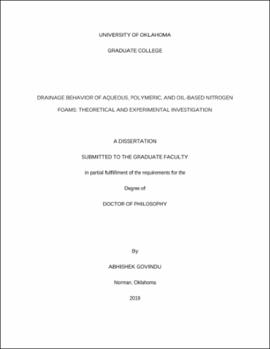| dc.description.abstract | Foams can be formulated to have a wide range of densities and viscosities. This unique behavior makes foam suitable for underbalanced drilling where pressure exerted on formation is maintained below pore pressure and at the same time, favorable conditions for a good hole-cleaning can be established in the wellbore. Foams are also used as in fracturing, cementing, and, enhanced oil recovery applications. However, the disadvantage of foam is its inherent instability. The stability of aqueous foams in vertical conduits has been extensively investigated. However, in many industrial applications such as underbalanced drilling foam is used in inclined configurations. The stability of foams inclined conduits is not well understood. The effect of geometry is often ignored. In addition, polymer-based and non-aqueous foams with more complex flow and stability behavior are becoming more common. As a result, there is a strong need to investigate foams to better understand the effects of different operational factors (inclination, conduit geometry, base fluid type, and shearing) on their stability. Thus, the main goal of this study is to investigate each of these factors with respect to their impact on foam stability.
To achieve this, foam stability experiments were conducted in concentric annulus and straight pipe sections. The pipe section is manufactured from a fully transparent PVC pipe, enabling visual inspection of foam structure and liquid drainage. The annulus is made of stainless steel casing and a rotating inner PTFE (polytetrafluoroethylene) rod. Three types of foams (aqueous, polymeric-based and oil-based foams) were used in the investigation. All tests were performed at 400 KPa and ambient temperature (22 ± 2oC). Foam quality was ranged from 40 - 80%, except for oil-based foam which was limited to 70% due to instability at high qualities. Foam rheology data was obtained from pipe viscometers before conducting stability tests. Two inclination angles (0o and 30o) were considered in this study. For tests conducted in the annulus, the rotation speed of the inner rod was varied (0, 4, and 7 rpm) to examine the impact of shearing on foam stability. Hydrostatic pressure data measured from the annular test section is converted into density profiles, which are used to determine the drained liquid volume as a function of time. In straight pipe sections, the volume of drained liquid was measured using a measuring tape. A digital camera with a microscope was used to capture images of foam in real-time to examine the process of foam decay (i.e. the degree of bubble coarsening and coalescence).
Foam stability increased with quality. For a given quality, foam prepared with polymeric fluid was the most stable, while oil-based foam was the least. The wall effects can hinder bubble and drained liquid motion and consequently delay drainage. As a result, foam drained more slowly in the annulus than in pipe. Inclining the test sections resulted in much faster drainage, possibly due to the formation of a liquid layer between foam structure and container walls that flows down due to gravity, effectively avoiding the hydraulic flow resistance of foam structure. The effect of shearing on drainage was minimal for the level of shear rate applied. Channel-dominated model developed in this study is suitable for all foams considered (40-80%). Node-dominated model is not recommended for these wet foams as it tends to over predict liquid volume fractions at early time steps. | en_US |
